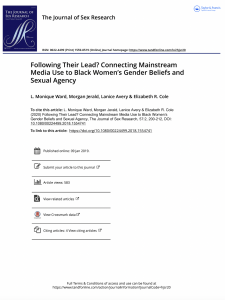Discrimination
Connecting Mainstream Media Use to Black Women’s Gender Beliefs and Sexual Agency
 Full Article Name: Following Their Lead? Connecting Mainstream Media Use to Black Women’s Gender Beliefs and Sexual Agency
Full Article Name: Following Their Lead? Connecting Mainstream Media Use to Black Women’s Gender Beliefs and Sexual Agency
Open Access: No
Abstract
Although media exposure has emerged as a significant predictor of consumers’ sexual decision making, less is known about the mechanisms involved and about the dynamics of these relations for adults, in general, and for African American adults, in particular. To address these gaps, we used structural equation modeling (SEM) to test whether heterosexual Black women’s endorsement of traditional gender and sexual roles mediates connections between their consumption of four mainstream media (music videos, reality TV programming, movies, and women’s magazines) and three dimensions of their sexual well-being (sexual assertiveness, sexual inhibition, and sexual deception). We surveyed 594 heterosexual Black women aged 17 to 55 who were undergraduate and graduate students at two universities (one historically Black university and one predominantly White institution). Results confirmed expectations, such that greater media consumption was associated with greater support of traditional gender and sexual roles; in turn, endorsing these roles predicted lower levels of sexual assertiveness, greater sexual inhibition, and more frequent use of sexual dishonesty to retain a partner. We discuss implications of these findings for psychology and sexuality research and also for Black women’s sexual relationships.
Citation
Ward, L. M., Jerald, M., Avery, L., & Cole, E. R. (2019). Following their lead? Connecting main-
stream media use to Black women’s gender beliefs and sexual agency. The Journal of Sex Research, 57(2), 200–212. https://doi.org/10.1080/00224499.2018.1554741
